-
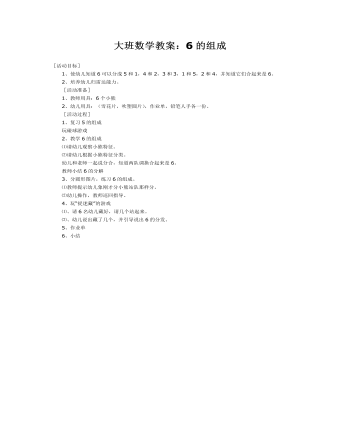
大班数学教案:6的组成
2、培养幼儿归雷达能力。 [活动准备]1、教师用具:6个小熊2、幼儿用具:(雪花片,吹塑圆片),作业单,铅笔人手各一份。 [活动过程]1、复习5的组成 玩碰球游戏2、教学6的组成⑴请幼儿观察小熊特征。⑵请幼儿根据小熊特征分类。 幼儿和老师一起说分合,知道两队调换合起来是6。 教师小结6的分解
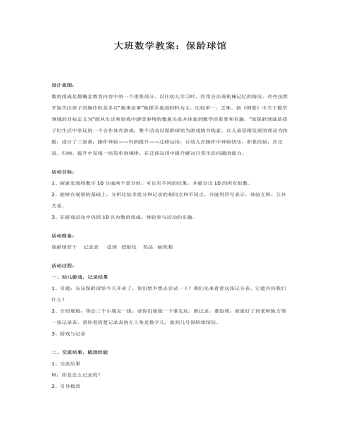
大班数学教案:保龄球馆
活动目标: 1、探索发现将数字10分成两个部分时,可以有不同的结果,并能分出10的所有组数。 2、能够在观察的基础上,分析比较多组分和记录的相同点和不同点,并能用符号表示,体验互换、互补关系。 3、在游戏活动中巩固10以内数的组成,体验参与活动的乐趣。 活动准备: 保龄球若干 记录表 皮球 投影仪 奖品 抽奖箱 活动过程:一、幼儿游戏,记录结果 1、引题:乐乐保龄球馆今天开业了,你们想不想去尝试一下?我们先来看看这张记分表,它能告诉我们什么? 2、介绍规则:等会三个小朋友一组,请你们商量一下谁先玩,谁记录,谁捡球,商量好了到老师地方领一张记录表,请你看清楚记录表的左上角是数字几,就到几号保龄球馆玩。 3、游戏与记录
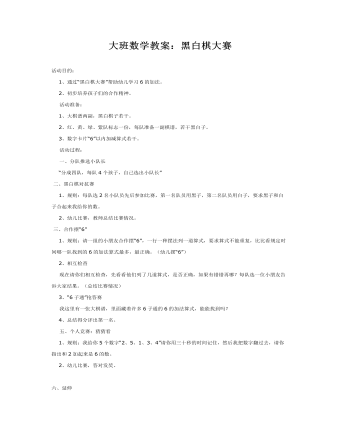
大班数学教案:黑白棋大赛
活动准备: 1、大棋谱两副,黑白棋子若干。 2、红、黄、绿、紫队标志一份,每队准备一副棋谱,若干黑白子。 3、数字卡片“6”以内加减算式若干。 活动过程: 一、分队推选小队长 “分成四队,每队4个孩子,自己选出小队长” 二、黑白棋对抗赛 1、规则:每队选2名小队员先后参加比赛,第一名队员用黑子,第二名队员用白子,要求黑子和白子合起来我给你的数。 2、幼儿比赛,教师总结比赛情况。
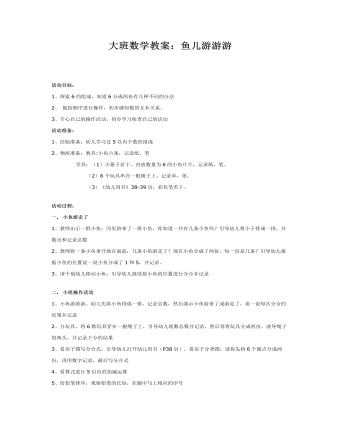
大班数学教案:鱼儿游游游
2、能按顺序进行操作,初步感知数的互补关系。 3、专心自己的操作活动,初步学习检查自己的活动 活动准备: 1、经验准备:幼儿学习过5以内个数的组成 2、物质准备:教具:小鱼六条,记录纸,笔 学具:(1)小篓子若干,内放数量为6的小鱼片片,记录纸,笔。 (2)6个玩具串在一根绳子上,记录单,笔。 (3)《幼儿用书》38-39页,彩色笔若干。活动过程:一. 小鱼游走了 1、教师出示一群小鱼:河里游来了一群小鱼,你知道一共有几条小鱼吗?引导幼儿将小于排成一排,并数出和记录总数 2、教师将一条小鱼拿开放在面前:几条小鱼游走了?现在小鱼分成了两份,每一份是几条?引导幼儿根据小鱼的位置说一说小鱼分成了1和5,并记录。 3、请个别幼儿移动小鱼,引导幼儿继续按小鱼的位置进行分合并记录
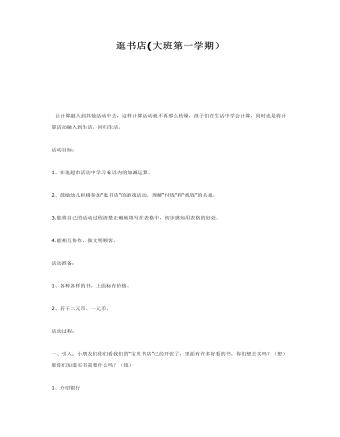
大班数学教案:逛书店
1、在逛超市活动中学习6以内的加减运算。2、鼓励幼儿积极参加“逛书店”的游戏活动,理解“付钱”和“找钱”的关系。3.能将自己的活动过程清楚正确地填写在表格中,初步感知用表格的好处。4.能相互协作,做文明顾客。活动准备:1、各种各样的书,上面标有价格。2、若干二元币、一元币。
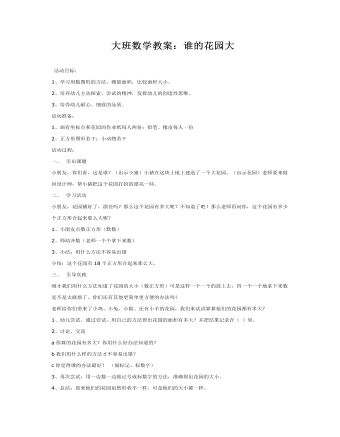
大班数学教案:谁的花园大
2、培养幼儿主动探索、尝试的精神,发挥幼儿的创造性思维。 3、培养幼儿耐心、细致的品质。 活动准备: 1、画有坐标点和花园的作业纸每人两份;铅笔、橡皮每人一份 2、正方形图形若干;小动物若干 活动过程: 一、 引出课题 小朋友,你们看,这是谁?(出示小猪)小猪在这块土地上建造了一个大花园,(出示花园)老师要来做回设计师,帮小猪把这个花园打扮的漂亮一些。 二、 学习活动 小朋友,花园铺好了,漂亮吗?那么这个花园有多大呢?不知道了吧!那么老师再问你,这个花园有多少个正方形合起来那么大呢? 1、小朋友点数正方形(默数) 2、师幼齐数(老师一个个拿下来数) 3、小结:用什么方法不容易出错 小结:这个花园有18个正方形合起来那么大。

大班数学教案:编译密码
2.锻炼幼儿运用逆向思维的方式进行运算,培养幼儿的运算兴趣;3.让幼儿充分感受成功解决数学问题的乐趣。 活动准备教师准备:电话号码卡两张;l一10的数字卡;幼儿准备:熟悉自己家的电话号码;电话号码册、铅笔、橡皮等。 活动组织:1.导入活动师:昨天晚上,我接到从我们班转学的豪豪小朋友打来的电话,他说很想你们,那你们想不想他?如果想他,怎样和他联系?(让幼儿自由讨论,引出打电话的想法。)师:他家的电话号码是xxxxxxxx,(出示电话号码)我们来数数他家的电话号码是几位?(幼儿一起点数)他家电话号码的第几位数是几?
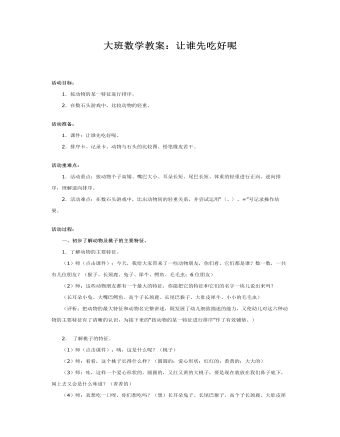
大班数学教案:让谁先吃好呢
活动准备:1.课件:让谁先吃好呢。2.排序卡、记录卡、动物与石头的比较图、铅笔橡皮若干。活动重难点:1.活动重点:按动物个子高矮、嘴巴大小、耳朵长短、尾巴长短、体重的轻重进行正向、逆向排序,理解逆向排序。2.活动难点:在数石头游戏中,比出动物间的轻重关系,并尝试运用“〈、〉、=”号记录操作结果。活动过程: 一、初步了解动物及桃子的主要特征。1.了解动物的主要特征。 (1)师(点击课件):今天,我给大家带来了一些动物朋友,你们看,它们都是谁?数一数,一共有几位朋友?(猴子、长颈鹿、兔子、犀牛、鳄鱼、毛毛虫;6位朋友) (2)师:这些动物朋友都有一个最大的特征,你能把它的特征和它们的名字一块儿说出来吗? (长耳朵小兔、大嘴巴鳄鱼、高个子长颈鹿、长尾巴猴子、大肚皮犀牛、小小的毛毛虫) (评析:把动物的最大特征和动物名完整讲述,既发展了幼儿细致描述的能力,又使幼儿对这六种动物的主要特征有了清晰的认识,为接下来的“按动物的某一特征进行排序”作了有效铺垫。)2.了解桃子的特征。 (1)师(点击课件):咦,这是什么呢?(桃子) (2)师:看看,这个桃子长得什么样?(圆圆的;爱心形状;红红的;黄黄的;大大的) (3)师:哇,这样一个爱心形状的、圆圆的,又红又黄的大桃子,要是现在就放在我们鼻子底下,闻上去又会是什么味道?(香香的) (4)师:真想吃一口呀,你们想吃吗?(想)长耳朵兔子、长尾巴猴子、高个子长颈鹿、大肚皮犀牛、大嘴巴鳄鱼、小小的毛毛虫和我们一样,看到这个桃子,馋得口水都快流出来了,都想先吃到这个大桃子。 (评析:对桃子形状、颜色、大小特征的讲述,以及对桃子气味的猜测,既“勾”起了幼儿品尝桃子的欲望,又“唤”起了他们对动物看到桃子后急切品尝心境的理解,适时、巧妙的引出了本次活动的一条暗藏线索“让谁先吃好呢?”。)二、按动物的某一特征排序。1.按动物高矮、大小、长短排序。 (1)按个子的高矮排序。A.师(点击课件):“按照个子的顺序吃怎么样?”长颈鹿把脖子挺得直直的,先说了一句。那就得先量量看,谁的个子最高了。毛毛虫说:“不能站在高的地方量,量的时候不能把尾巴算上”小兔说:“踮起脚来量也不行。”B.师(点击课件):瞧,他们每人都找了一棵大树开始量了起来。动物们和大树的什么比?(树干)C.师:它们一个个都紧贴着树干,认真的量着。小朋友,你们看出来了吗?谁最高?第二高是谁呢?第三高呢?接下来轮到谁?第五高?最矮的一个是谁呀?D.出示高矮排序图。E.讲述故事:“看见了吧?看见了吧?我的个子最高,所以得我先吃!”长颈鹿把脖子伸得长长的,刚要去咬那个又大又红的桃子。 (2)按嘴巴的大小排序。A.师(点击课件):“不行,这么大的桃子,当然得嘴巴最大的先吃了”鳄鱼张着一张大嘴,站了出来。到底谁的嘴巴最大?B.师(点击课件):“我的嘴巴大!”(犀牛声音)“谁说的!我的嘴巴才是最大的呢!”(鳄鱼声音)C.师:你们说,谁的嘴巴最大?(鳄鱼)E.讲述故事:“听见没,听见没有?我的嘴巴最大,当然是我先吃了!”鳄鱼使足了全身的劲儿,张大嘴巴,马上就要咬到这个又大又红的桃子了…… (3)按耳朵的长短排序。A.师(点击课件):“这么做不行!”蹦蹦跳跳的兔子竖着耳朵跑过来。B.师:欸,兔子会说什么呢?(谁耳朵长谁吃)C.师:那就是说得按什么顺序来吃桃子?(长短顺序)D.师:按什么的长短顺序,谁能完整的说一说?(按耳朵的长短顺序吃)E.师(点击课件):对,应该按照耳朵长短的顺序、谁的耳朵长谁先吃!那就比比,看看到底谁的耳朵最长吧。“看,还是我的耳朵最长吧!”小个子的兔子好不容易够到长颈鹿的脖子,说道。

大班数学教案:7的组成
2、通过讨论、分析,理解一个数分成两个部分,如一个不风增加1,另一个部分就要减少1。 活动准备 塑料小鸭学具人手42只。 活动过程 一、复习6的组成 玩“碰球游戏”,出现数咔,师问:这数是几?答“6”。师:今天玩碰游戏,教师与小朋友的数合起来是6。(例如),师:我的1球碰几球?答:你的1球碰5球)教师问,小朋友可集体回答,也可小组回答,也可个别回答。 二、集体尝试活动
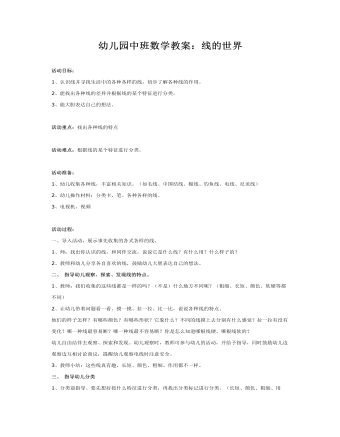
中班数学教案:线的世界
活动重点:找出各种线的特点 活动难点:根据线的某个特征进行分类。 活动准备:1、幼儿收集各种线,丰富相关知识。(如毛线、中国结线、棉线、钓鱼线、电线、尼龙线)2、幼儿操作材料:分类卡、笔、各种各样的线。3、电视机、视频 活动过程:一、导入活动,展示事先收集的各式各样的线。1、师:找出你认识的线,和同伴交流,说说它是什么线?有什么用?什么样子的?

中班数学教案:会变的图形
教学准备: 正方形纸、小刀。 教学过程: (一)变魔术 让幼儿猜想正方形能不能变成三角形、小正方形、长方形。然后将纸折叠,剪开变为各种图形。 将剪开的图形再拼成正方形。

新人教版高中英语必修2Unit 2 Wildlife Protection-Listening and Speaking教案
This lesson is about wildlife protection. The listening and speaking is about “How to protect endangered wildlife ?” Faced with the facts and numbers of wildlife loss, people begin to detect the reasons, then people such as the celebrities (Prince William and Yao Ming) are calling on to protect them. So students are guided to enhance the awareness of protecting wildlife and try to take part in some volunteer activities of protecting wildlife.1. Predict the content by using visuals. 2. Learn to use the sentences such as “I’m concerned about.... But now they are in danger. I want to know the reasons/why./ What can we do to protect them ?3. Learn from the stars like Prince William and Yao Ming and enhance the awareness of protecting wildlife.4. Guide students to try to put forward the solutions to the problems of wildlife protection and then discuss them with partners and present the results of discussion.5. Master the pronunciation of stressed syllables.1. Learn from the stars like Prince William and Yao Ming and enhance the awareness of protecting wildlife.2. Guide students to try to put forward the solutions to the problems of wildlife protection and then discuss them with partners and present the results of discussion.3. Learn to use the sentences such as “I’m concerned about.... But now they are in danger. I want to know the reasons/why./ What can we do to protect them ?4. Master the pronunciation of stressed syllables.Part A Listening and Speaking--- How to save endangered wildlifeStep 1 Lead in1. Point at the pictures on P14 and ask Q1: What message do these posters share?

新人教版高中英语必修2Unit 2 Wildlife Protection-Discovering Useful Structure教案一
The activity topic of this section is "report an ongoing event", and the structure is the passive voice of present continuous tense. Rare wild animals are suffering from large-scale poaching, and species are on the brink of danger. Rescue operations are underway. "Being" and "suffering" are the meanings of the present progressive passive voice.The usage of present progressive passive voice is of great importance in writing a good discourse and appreciating some difficult language items, so it is vital to master it and use it flexibly in a context.1. Motivate Ss to deepen the understanding of the usage of present progressive passive voice in a fixed context.2. Enable Ss to master the usage of present progressive passive voice and use it flexibly in a context.3. Lead Ss to construct sentences or appreciate sentences used master it and use it flexibly in a context.1. Help students to appreciate the function of the usage of present progressive passive voice in a sentence2. Instruct students to write essays using the proper usage of present progressive passive voice.Look at the picture and tell me what are workers doing? What is the house being done?

新人教版高中英语必修2Unit 2 Wildlife Protection-Reading and Thinking教案一
The listening and speaking part aims at how to protect and help endangered animals by listening, speaking and talking about the facts and reasons. This lesson analyzes the decreasing clause of Tibetan antelope population and the measures of protecting Tibetan antelopes. So students can be guided to learn to analyse the title and use different reading skills or strategies, like scanning, skimming and careful reading.1. Read quickly to get the main ideas and the purpose of going to Tibetan; read carefully to understand what the author see and think.2. Understand the sentences of the present continuous passive voice such as “Much is being done to protect wildlife.” and the inverted sentence “Only when we learn to exist in harmony with nature can we stop being a threat to wildlife and to our planet.”3. Enhance the awareness of protecting wildlife.4. Cultivate the reading methods according to different materials.1. Read quickly to get the main ideas and the purpose of going to Tibetan; read carefully to understand what the author see and think.2. Understand the sentences of the present continuous passive voice such as “Much is being done to protect wildlife.” and the inverted sentence “Only when we learn to exist in harmony with nature can we stop being a threat to wildlife and to our planet.”3. Cultivate the reading methods according to different materials.Step 1 Leading-inWatch a video about elephants and whales and then ask:Why are they endangered ? They are killed/hunted

新人教版高中英语必修2Unit 2 Wildlife Protection-Listening &Speaking&Talking教案
Listening and Speaking introduces the topic of “how to save endangered wildlife and help wildlife in their neighborhood.” Due to the continuous deterioration of the living environment, a large number of wild animals are always facing the threat of endangered or extinction. Listening and speaking period enables students to understand the fact and reason why wild species are disappearing from the earth at an amazing speed, and realize that human beings ought to enhance the awareness of protecting wild species as soon as possible.Listening and Talking introduces the theme of " how to help wildlife in Ss’ neighborhood.". Now there are many volunteers who spontaneously protect wild animals, carry out various activities according to local conditions, and contribute their own strength to local animal protection with practical actions. Middle school students are also enthusiastic participants. They organize activities in their spare time, and take this opportunity to make friends, broaden their horizons, cultivate team spirit and communication skills. This section describes a bird watching activity organized by several middle school students of Bird watching Club. It aims to stimulate students' interest, improve their understanding of bird watching activities, and use the language structure of “being used for; in order to, so as to, to, so that, in order that ” to express the purpose for communication and discussion.1. Guide students to understand the content of listening texts in terms of using visuals to predict content.2. Cultivate students' ability to guess the meaning of words in listening; discuss with their peers how to save endangered wildlife and help wildlife in their neighborhood.3. Instruct students to use functional sentences of the dialogue such as “I am concerned about…” “what do you know about the endangered animals in…" and so on to talk about one of the endangered animals.

新人教版高中英语必修2Unit 2 Wildlife Protection-Reading For Writing教案一
1. 标题首先根据海报的特点、格式写明标题。海报中往往把内容作为大标题。例如: Save the earth, Save the birds。2. 正文部分不同的海报其正文部分的侧重点不同。对于介绍性的海报, 首先要引出话题, 其次列出原因, 最后是总结。对于宣传类的海报, 要写明具体内容, 如: 活动内容, 地点以及参加活动的注意事项, 主持或举办单位等。1. 图片: 要选择引人注目的图片, 与主题要相关, 色彩明亮。话题句式 1. It is a treasure of our country. 它是我国的国宝。2. Believe it or not, at present only several thousand pandas exist in the world. 信不信由你, 目前世界上仅现存几千只熊猫。 3.It’s because of human activities that tigers are endangered. 正是因为人类的活动, 老虎处于濒危的状态。4. Many wild animals are in danger of dying out. 很多野生动物面临着灭绝的危险。 5. The government has taken effective measures to protect them. 政府已采取有效的措施来保护它们。6. People should raise the awareness of the protection of wild animals. 人们应该提高保护野生动物的意识。 7. It’s amazing that there are merely less than 1, 000 finless porpoises living in China. 非常令人吃惊, 目前中国仅有不足1 000只江豚。

人教版高中历史必修3文学的繁荣教案3篇
苏联文学的沿革,既反映了苏联社会的伟大思想性变革,又反映了苏联文坛活跃与混乱并存的局面,特别是其所具有强烈的意识形态色彩是苏联社会深层次变化的风向标。(2)20世纪的亚、非、拉美文学20世纪亚、非、拉美文学的繁荣伴随着民族民主运动的高涨,其主流都体现了反对殖民压迫、反对社会不公的爱国主义精神。出现了许多颇有影响的作家和作品。泰戈尔是印度近现代文学的光辉代表,为印度现代民族主义奠定了基础。其代表作《戈拉》塑造了爱国的印度民族主义知识分子形象。泰戈尔是首位获诺贝尔文学奖的东方作家。鲁迅是中国文学革命的巨匠,他的《呐喊》集,昭示着中国新文学时代的到来。哥伦比亚作家马尔克斯的《百年孤独》,描绘加勒比海沿岸小城百年孤独的原因及打破这种状态的途径。
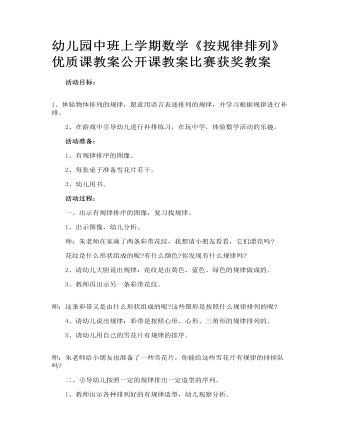
幼儿园中班上学期数学《按规律排列》优质课教案公开课教案比赛获奖教案
一、出示有规律排序的图像,复习找规律。 1、出示图像,幼儿分析。 师:朱老师在家画了两条彩带花纹,我想请小朋友看看,它们漂亮吗? 花纹是什么形状组成的呢?有什么颜色?你发现有什么规律吗? 2、请幼儿大胆说出规律:花纹是由黄色、蓝色、绿色的规律做成的。 3、教师再出示另一条彩带花纹。
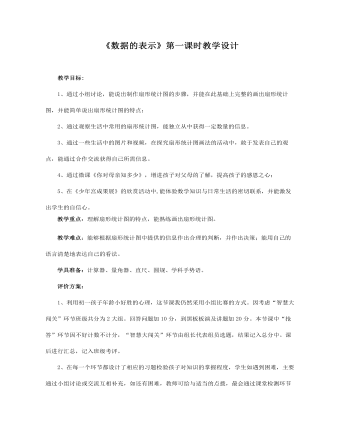
数据的收集与整理 3 数据的表示教案教学设计
创设情境,导入新课:你对母亲知多少师问1:我们5月份刚过了一个重要的节日,你知道是什么吗?----母亲节。师问2:那你知道妈妈的生日吗?(举手示意),每个妈妈都知道自己孩子的生日,请不知道的同学回家了解一下,多关心一下自己的父母。师问3:那你知道妈妈最爱吃的菜吗?你可以选择知道、不知道或者是没有爱吃的(拖动白板上相对应的表情符号)。请大家用不同的手势表示出来。我找3名同学统计各组的数据,写在黑板上(随机找3名学生数人数)。下面我来随机采访一下:你妈妈最喜欢吃的菜是什么?(教师随机采访,结合营养搭配和感恩教育)
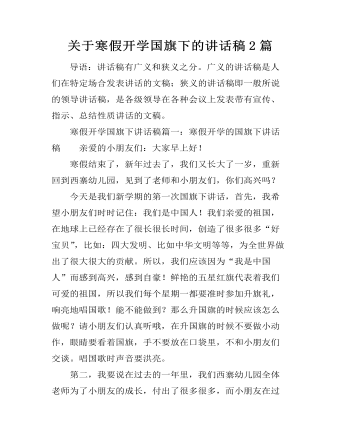
关于寒假开学国旗下的讲话稿2篇
导语:讲话稿有广义和狭义之分。广义的讲话稿是人们在特定场合发表讲话的文稿;狭义的讲话稿即一般所说的领导讲话稿,是各级领导在各种会议上发表带有宣传、指示、总结性质讲话的文稿。寒假开学国旗下讲话稿篇一:寒假开学的国旗下讲话稿 亲爱的小朋友们:大家早上好!寒假结束了,新年过去了,我们又长大了一岁,重新回到西寨幼儿园,见到了老师和小朋友们,你们高兴吗?今天是我们新学期的第一次国旗下讲话,首先,我希望小朋友们时时记住:我们是中国人!我们亲爱的祖国,在地球上已经存在了很长很长时间,创造了很多很多“好宝贝”,比如:四大发明、比如中华文明等等,为全世界做出了很大很大的贡献。所以,我们应该因为“我是中国人”而感到高兴,感到自豪!鲜艳的五星红旗代表着我们可爱的祖国,所以我们每个星期一都要准时参加升旗礼,响亮地唱国歌!能不能做到?那么升国旗的时候应该怎么做呢?请小朋友们认真听哦,在升国旗的时候不要做小动作,眼睛要看着国旗,手不要放在口袋里,不和小朋友们交谈。唱国歌时声音要洪亮。

